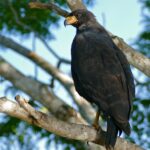The great black hawk (Buteogallus urubitinga) is a bird of prey that belongs to the family Accipitridae, which includes eagles, hawks, and Old World vultures. This species is known for its distinctive black plumage, broad wings, and short tail with a white base and a broad black tip. Understanding the population dynamics of the great black hawk is crucial for its conservation and management.
Habitat and Distribution
The great black hawk is primarily found in Mexico and Central and South America, with its range extending from Mexico to Argentina. It typically inhabits tropical and subtropical forests, wetlands, and riparian areas, often near water sources such as rivers and lakes. The species is not migratory and remains in its native range throughout the year.
Physical Characteristics
 Image source: Great Black Hawk by Bernard DUPONT
Image source: Great Black Hawk by Bernard DUPONT
The great black hawk is a large bird of prey, with a wingspan that can reach up to 1.5 meters (4.9 feet). Its plumage is predominantly black, with a white base and a broad black tip on its short tail. The bill is black, and the legs and cere (the area at the base of the bill) are yellow. Immature birds have a darker brown plumage with spotting and streaks, and their underparts are buff with dark spots.
Feeding Habits
The great black hawk is a versatile predator, feeding on a variety of prey, including reptiles, small vertebrates, and large insects. It often hunts on foot, stalking its prey and then swooping down to capture it. The species is known to raid the nests of other birds, such as the hoatzin, in search of eggs and chicks.
Nesting and Reproduction
The great black hawk builds a large stick nest in the canopy of a tree, usually near a water source. The female typically lays a single dark-blotched whitish egg, which both parents take turns incubating. The chick is cared for by both parents until it is able to fend for itself.
Population Status and Conservation
The great black hawk is considered a rare species in the United States, but it is more common in its native range in Mexico and South America. The species is not currently listed as threatened or endangered, but its population status and trends are not well-documented in many parts of its range.
Vagrant Sightings in the United States
In 2018, a great black hawk was first recorded in the ABA (American Birding Association) area on South Padre Island, Texas, in April. The same individual was later spotted in Biddeford, Maine, in August of that year, making it the “Craziest Vagrant of 2018” according to the ABA. After disappearing for several months, the bird reappeared in Deering Oaks park in Portland, Maine, where it remained until being rescued during a snowstorm in January 2019. Unfortunately, the bird was euthanized due to extensive frostbite.
Conclusion
The great black hawk is a fascinating bird of prey with a unique appearance and interesting behaviors. Understanding its population dynamics and conservation status is crucial for ensuring the long-term survival of this species. By learning more about the great black hawk, we can better appreciate the diversity of the natural world and take steps to protect this remarkable bird.
References:
– Animalia.bio – Great Black Hawk
– All About Birds – Common Black Hawk
– Britannica – Great Black Hawk


